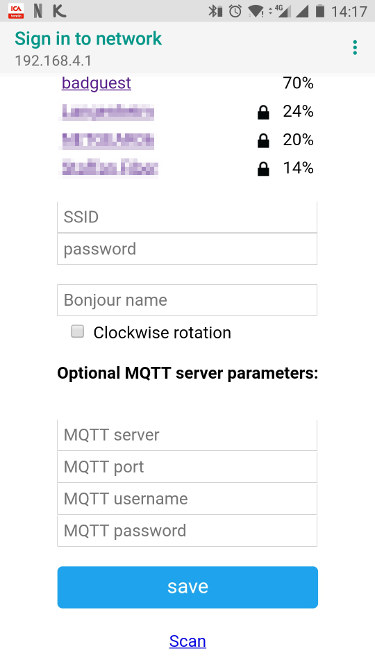This repo has been archived as a complete redesign is on its way - including physical components
WebSocket based version of motor-on-roller-blind. I.e. there is no need of an MQTT server but MQTT is supported as well - you can control it with WebSockets and/or with MQTT messages.
3d parts for printing are available id 3d_parts folder.
PCB sources are available in pcb folder.
- project ported to Platformio
- changed 3d parts according to small tube ~16mm
- added functionality of 3 step motors
- add current state broadcasting during blinds moving
- add wipe setting function
- add pcb sources
- A tiny webserver is setup on the esp8266 that will serve one page to the client
- Upon powering on the first time WIFI credentials, a hostname and - optional - MQTT server details is to be configured. You can specify if you want clockwise (CW) rotation to close the blind and you can also specify MQTT authentication if required. Connect your computer to a new WIFI hotspot named BlindsConnectAP. Password = nidayand
- Connect to your normal WIFI with your client and go to the IP address of the device - or if you have an mDNS supported device (e.g. iOS, OSX or have Bonjour installed) you can go to http://{hostname}.local. If you don't know the IP-address of the device check your router for the leases (or check the serial console in the Arduino IDE or check the
/raw/esp8266/registerMQTT message if you are using an MQTT server) - As the webpage is loaded it will connect through a websocket directly to the device to progress updates and to control the device. If any other client connects the updates will be in sync.
- Go to the Settings page to calibrate the motors with the start and end positions of the roller blind. Follow the instructions on the page
- When it connects to WIFI and MQTT it will send a "register" message to topic
/raw/esp8266/registerwith a payload containing chip-id and IP-address - A message to
/raw/esp8266/[chip-id]/in[1-3]will steer the selected blind according to the "payload actions" below - Updates from the device will be sent to topic
/raw/esp8266/[chip-id]/outas JSON
Simply do not enter any string in the MQTT server form field upon WIFI configuration of the device (step 3 above)
update- send broadcast message about current state via MQTT and websockets0-100- (auto mode) A number between 0-100 to set % of opened blind. Requires calibration before use. E.g.50will open it to 50%
- Stepper_28BYJ_48: https://github.com/thomasfredericks/Stepper_28BYJ_48/
- PubSubClient: https://github.com/knolleary/pubsubclient/
- ArduinoJson: https://github.com/bblanchon/ArduinoJson
- WIFIManager: https://github.com/tzapu/WiFiManager
- WbSocketsServer: https://github.com/Links2004/arduinoWebSockets



